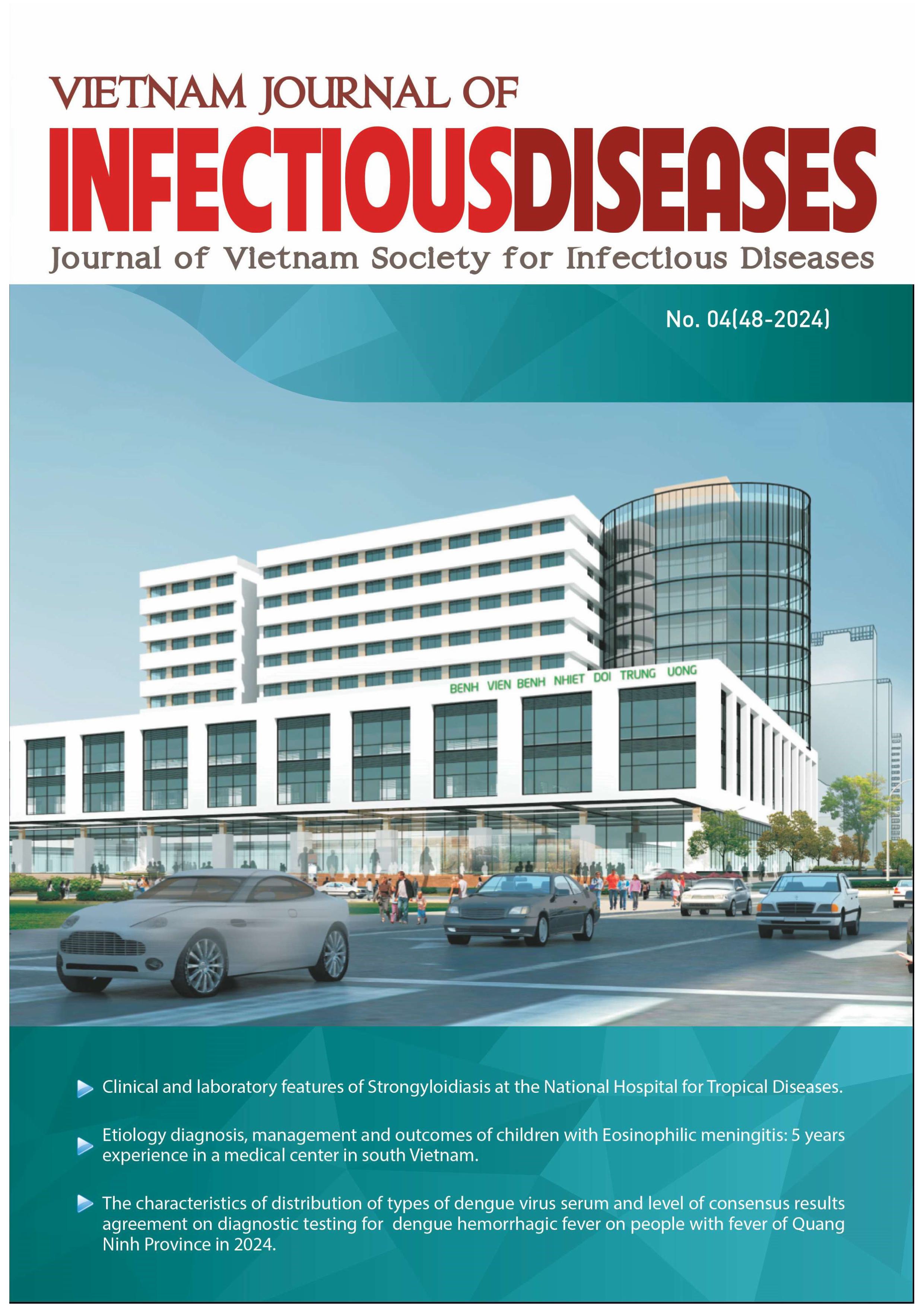CLINICAL AND LABORATORY FEATURES OF STRONGYLOIDIASIS AT THE NATIONAL HOSPITAL FOR TROPICAL DISEASES
Nội dung chính của bài viết
Tóm tắt
Objectives: Describe clinical and laboratory features of strongyloidiasis at the National Hospital for Tropical Diseases from November 2018 to January 2024.
Subjects and methods: A cross-sectional, retrospective study. Inclusion criteria were based on direct microscopy of Strongyloides stercoralis larvae in body fluid specimens (stool, gastric fluid, respiratory tract fluid, cerebrospinal fluid, etc.).
Results: 48 patients were included in the study, 85.42% of cases were male, with a median age of 64.5 years. 83.33% of patients had comorbidities. 60.42% of patients were in the intensive care unit (ICU).
There were 33.33% of uncomplicated strongyloidiasis and 66.67% of severe strongyloidiasis. Severe strongyloidiasis had higher rates of fever and neutrophilia than uncomplicated disease. 20.83% of cases had co-infection with sepsis; 27,08% of cases had bacterial co-infection in cerebrospinal fluid. The most common bacteria were E. coli and K. pneumoniae.
Conclusions: Patients were mainly male, aged > 60, and had comorbidities. The rate of patients with severe strongyloidiasis is 66.67%. Severe strongyloidiasis had significantly higher rates of fever and neutrophilia than uncomplicated strongyloidiasis.
Chi tiết bài viết
Từ khóa
Strongyloidiasis, Strongyloides stercoralis
Tài liệu tham khảo
doi:10.3390/pathogens9060468.
2. Fleitas PE, Travacio M, Martí-Soler H, et al. The Strongyloides stercoralis-hookworms association as a path to the estimation of the global burden of strongyloidiasis: A systematic review. PLoS Negl Trop Dis. 2020;14(4):e0008184. doi:10.1371/journal.pntd.0008184.
3. Diep NTN, Thai PQ, Trang NNM, et al. Strongyloides stercoralis seroprevalence in Vietnam. Epidemiol Infect. 2017;145(15):3214-
3218. doi:10.1017/S0950268817002333.
4. Van De N, Minh PN, Van Duyet L, MasComa S. Strongyloidiasis in northern Vietnam: epidemiology, clinical characteristics and molecular diagnosis of the causal agent. Parasit Vectors. 2019;12(1):515. doi:10.1186/s13071-019-3776-1.
5. Buonfrate D, Requena-Mendez A, Angheben A, et al. Severe strongyloidiasis: a systematic review of case reports. BMC Infect
Dis. 2013;13:78. doi:10.1186/1471-2334-13-78.
6. Boggild AK, Libman M, Greenaway C, McCarthy AE; Committee to Advise on Tropical Medicine; Travel (CATMAT). CATMAT statement on disseminated strongyloidiasis: Prevention, assessment and management
guidelines. Can Commun Dis Rep. 2016;42(1):12-19. doi:10.14745/ccdr.v42i01a03.
7. Farthing M, Albonico M, Bisoffi Z, et al. World Gastroenterology Organisation Global Guidelines: Management of Strongyloidiasis
February 2018-Compact Version>. J Clin Gastroenterol. 2020;54(9):747-757. doi:10.1097/MCG.0000000000001369.
8. Nguyễn Trung Cấp, Đặng Quốc Tuấn, Phạm Ngọc Thạch. Đặc điểm lâm sàng, cận lâm sàng và điều trị bệnh nhân nhiễm Strongyloides
stercoralis nặng ở Bệnh viện Bệnh Nhiệt đới Trung ương và Bệnh viện Bạch Mai (2/2013 - 9/2019). Tạp chí Truyền nhiễm Việt Nam. 2020;1(29):49-53. doi:10.59873/vjid.v1i29.143.
9. Viney ME, Brown M, Omoding NE, et al. Why does HIV infection not lead to disseminated strongyloidiasis?. J Infect Dis. 2004;190(12):2175-2180. doi:10.1086/425935


